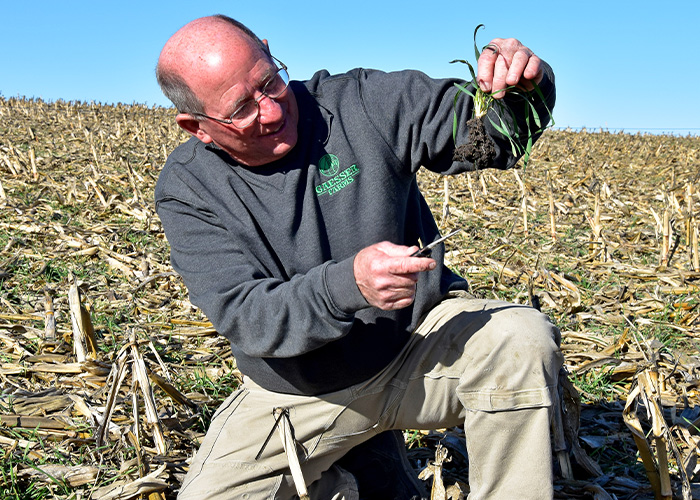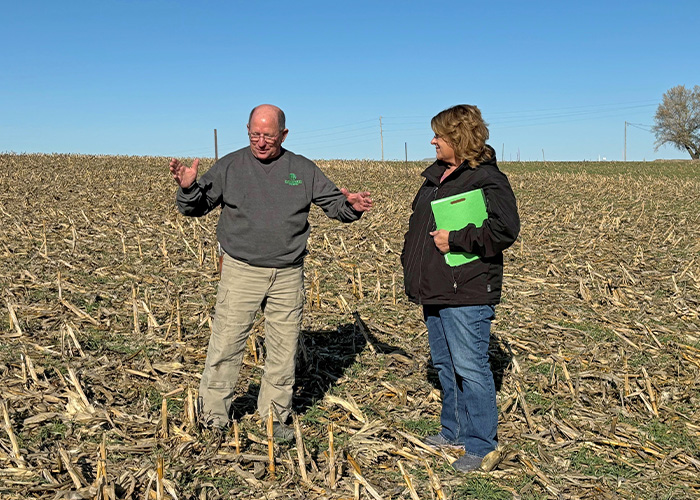This Friday meet Ray Gaesser, a farmer in Adams County, Iowa, who farms about 4,000 acres alongside his son, Chris. For more than 40 years Ray has farmed some of the best soils in Adams County. His mid-80s Corn Suitability Rating (CSR) – an index for measuring row crop productivity – far exceeds the county average of 62. His faith and responsibility to future generations are motivating factors for not only maintaining his cropland but improving it with healthy soil management.

After moving from Indiana in 1978, Ray and his wife, Elaine, purchased a 300-acre farm in southwest Iowa.
“We wanted opportunities and a place to farm,” he said. “Back then, the sign entering Iowa said, ‘A Place to Grow’ and later became ‘Fields of Opportunities.’ We found both here.”
In the 1980s, Ray began expanding his operation by purchasing and renting land from his neighbors. Through the years, Ray’s conservation focus has evolved from reducing soil erosion to improving soil health. Ray was an early adopter of no-till farming and installed grassed waterways and terraces for erosion protection.
“We have a responsibility to care for what we’ve been blessed with here – not only to the earth but to future generations. That’s what we believe in,” he said. “We have 30-40 inches of topsoil in some places, we want to protect that. What drives us is we want the land to be as good or better than when we took it over.”
A Mindset Change
After a four-inch rain in May 2008, Ray began to ponder other ways to protect his soil and crop residue. Following several more years of extreme, damaging rainfalls on his farm, Ray decided to try cover crops for extra protection, “We didn’t lose a lot of soil from those heavy rains, but we lost our surface protection.”
Ray gradually increased cover crop acreage from 200 to over 3,000 by 2017. He’s worked with USDA’s Natural Resources Conservation Service (NRCS) to further his cover crop efforts through a Environmental Quality Incentives Program (EQIP) Conservation Incentive Contract. These contracts are available nationwide and help producers address priority resource concerns, like sequestering carbon and improving water quality in high-priority areas.

For the past eight years the Gaessers have used a high clearance spreader to apply a cereal rye cover crop before soybean harvest and after corn harvest, and the benefits cereal rye provide have far exceeded Ray’s expectations.
“We haven’t taken a yield hit, our soil health is like we’ve never seen before,” he said. “Water infiltration has improved, and we leave no tracks in the field anymore.”
The results have been so dramatic that Missy Johnson, the district conservationist for NRCS in Adams County, utilizes Gaesser Farms for soil health field days.

“You can tell when you walk on Ray’s fields the difference in the soil – it’s spongy,” she said. “Fields that are tilled in Adams County are much harder to walk on.”
Missy says water infiltration on Gaesser Farms is amazing. “Water infiltration tests show Ray’s fields can absorb an inch of water in two to three seconds. Comparable fields with a history of tillage take seven to eight minutes to absorb that much water,” she says. “This tells us that the soil health improvements the Gaessers are making are helping to not only reduce soil erosion, but also reduce flooding and ponding.”
Cereal Rye Production
The Gaessers rest about 300 row crop acres annually and grow cereal rye for seed there instead. They harvest seed for their own cover crop use and sell some to other local producers. Ray sells the remaining rye to Revelton Distillery in Osceola, Iowa.

Ray is now semi-retired and Chris has slowly bought into the farm, planning to eventually take over full time.
“I feel good about what we’ve done here and for our future,” he said. “I think smart agriculture is using all the conservation practices that are proven successful, along with all the latest technology, to grow more and use less resources and protect the environment.”
More Information
Visit local farms, ranches, forests, and resource areas through our Fridays on the Farm stories. Meet farmers, producers and landowners who are working to improve their operations with USDA programs.
USDA offers a variety of risk management, disaster assistance, loan, and conservation programs to help producers weather ups and downs in the market and recover from natural disasters as well as invest in improvements to their operations. Learn about additional programs.
For more information about USDA programs and services, contact your local USDA service center.
Jason Johnson is a public affairs specialist for NRCS in Iowa.


